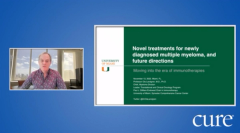
Educated Patient® Multiple Myeloma Summit Predicting Clinical Outcomes Presentation: November 13, 2022
Watch Dr. Francesco Maura, from Miami Sylvester Comprehensive Cancer Center, discuss how personalized prediction models can be used to identify the best treatments during the CURE® Educated Patient Multiple Myeloma Summit.
Episodes in this series

Utilizing personalized models to predict clinical outcomes for patients with multiple myeloma can improve probability of survival, but more must be done by the community to differentiate between different types of myeloma and improve accessibility of these models, explained Dr. Francesco Maura.
Genomic and demographic data from patients with multiple myeloma can be used to create individualized prediction models that can give “a blueprint to identify the best treatment for the patients,” explained Maura,an assistant professor of medicine at Miami Sylvester Comprehensive Cancer Center in Florida at the CURE® Educated Patient® Multiple Myeloma Summit.
In a recent interview with CURE®, Maura discussed the future of these models and the challenges currently faced in making such personalized models the standard of care for patients with multiple myeloma.
Challenges in Current Models
According to Maura, while outcomes for patients with multiple myeloma have improved significantly in the last 10 years, 10% to 20% of patients will die within the first two to three years of diagnosis. The reason for this gap, Maura explained, is that the prognostic models (mathematical models that relate a person's characteristics to the risk of a particular future outcome) currently being used to decide treatment for patients with multiple myeloma incorrectly assume that all myelomas are identical and do not use adequate specific information about the patients.
“If we cannot provide the individual risk of each patient,” Maura explained, “it is hard to identify any (specific) treatment. And that's why most of the patients are treated in the same way (even though) we know multiple myeloma is not one disease, but multiple subgroups (which should be treated differently).”
Maura is hoping to change this by creating individualized prediction models that take into account genomic and demographic data from patients with multiple myeloma to identify which treatment would most accurately stop the growth of the disease.
Improving Accessibility
Maura cautioned patients, however, to be careful when interpreting these models, explaining that, “patients don't (always) have all the elements to really understand what's going on with the model.” He clarified that cancer centers need to have patients’ genomic data for the models to be useful, which many currently do not have. Maura added that, because the models are so new, more data is needed to fine tune the results, which he hopes will happen over time.
Maura stated that he hopes to have a website where patients can access the models after their research is published but the timeline is still tentative.
Collaboration Between Community and Companies
Maura emphasized that collaboration between patients and drug companies is crucial to the successful implementation of these prediction models. “The best outcome we could offer,” Maura stated, “is that people start to share more data (by participating in) clinical trials, (and then) companies (will) work with us to (create) randomized trials.”
Maura explained that having a large data set and access to biorepositories (samples of biological material for laboratory research) is essential to accelerate the development of models to make accurate predictions for patients with multiple myeloma.
What is needed to improve the models, Maura concluded, “is a combination of how much the community will contribute, and companies, foundations and academic centers (using) the tool(s) to understand and interpret the data.”
For more news on cancer updates, research and education, don’t forget to















